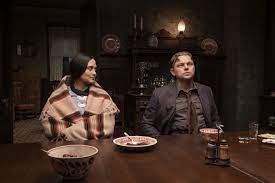
Martin Scorsese’s latest epic saga, “Killers of the Flower Moon,” marks a grand reunion with two of his favorite leading men, Leonardo DiCaprio and Robert De Niro. While it’s another exploration of the crime genre, this film distinguishes itself as a slow-burn period drama that demands a substantial 3 hours and 26 minutes of the viewer’s time.
Set against the backdrop of Oklahoma in the 1910-20s, “Killers of the Flower Moon” provides a visual escape from Scorsese’s usual New York milieu. It immerses the audience in the Osage community’s daily life, from weddings to funerals, and paints a vivid picture of the era. The film’s cinematography captures the essence of the countryside, transforming it into a character of its own.
Composer Robbie Robertson’s Western score complements the narrative, adding depth to the film’s atmosphere. Country music sets the timeline and offers a striking contrast to the unfolding bloodshed.
While the film boasts remarkable performances, particularly from DiCaprio, De Niro, and a standout appearance by Lily Gladstone, some critics note that it falls short of delivering the gut-wrenching slow burn seen in recent films like “The Power of the Dog.”
Nonetheless, “Killers of the Flower Moon” exemplifies Scorsese’s mastery of filmmaking, though its lengthy runtime may test viewers’ patience. The movie explores themes of morality, vengeance, and the cost of choices, with DiCaprio and De Niro displaying a profound understanding of Scorsese’s vision.
Scorsese’s adaptation of David Grann’s novel unfurls deliberately and meticulously, capturing the audience’s attention inch by inch. It’s a testament to the director’s artistry, culminating in a painstakingly built and evocatively executed epic.
“Killers of the Flower Moon” is not the typical Scorsese crime thriller but a profound exploration of history, crime, and the human condition, presented in the director’s signature style.
Sources By Agencies


